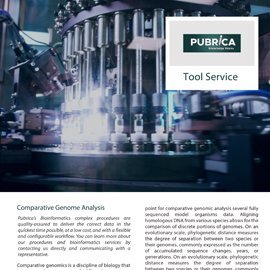Restriction site Analysis
Pubrica’s Bioinformatics complex procedures are quality-assured to deliver the correct data in the quickest time possible, at a low cost, and with a flexible and configurable workflow. You can learn more about our procedures and bioinformatics services by contacting us directly and communicating with a representative.
A restriction site is a DNA sequence that binds to a restriction enzyme and is approximately 6–8 base pairs in length. This restriction enzyme, which includes a variety of forms, was identified from bacteria. Their natural purpose is to cleave the viral DNA of invading viruses, rendering them inactive. Type II restriction enzymes recognize restriction sites and cleave DNA at specific points within or around the restriction site. The restriction enzyme EcoRI (after the E. coli strain from which it was first isolated) recognizes the DNA sequence. Restriction-site associated DNA sequencing (RADSeq) incorporates restriction enzyme digestion and Next-generation sequencing of restriction-site-adjacent regions. Depending on the RadSeq approach, bioinformatics studies of sequence data comprise a series of processes. The cost of sequencing numerous loci, samples and populations, and the desired coverage of the loci, are all potential sources of error and economic difficulties.
. Data consistency between sequencing runs and facilities can be a problem. RadSeq, with an average of one marker per 245 kb, can recognize crucial sections of the genome. RadSeq can be replaced by transcriptome sequencing (RNASeq) or targeted sequencing with a DNA probe. Alternatively, restriction sites in primers can be constructed as 5′-tails; they have no bearing on annealing (if necessary, lower the annealing temperature for the first few cycles and then raise it to the annealing temperature considering the whole primer, including the tail). If only the target restriction site is inserted, restriction enzymes will not cut efficiently; adding 4–6 bases at the 5′-end is usually required for optimum results.
Our comprehensive Bioinformatics Database services
Types of Bioinformatics: We undertake restriction site analysis with the help of using restriction enzyme such as EcoRI, RADSeq and RNASeq for research purpose.
Wide range of Sources: NCBI, BLAST, Pubmed, Pubmed Nucleotide, Pubmed Protein, Pubmed Gene, Pubmed Sequence.
Let experts support you’re Bioinformatics Research.
We’ll scale
up as your needs grow.
No compromising on integrity and quality. Our processes are well defined and flexible to ramp up as per your requirements.
Partnering with
you till the project end.
We come with you all the way. From design to market support

Pubrica Offerings
Pubrica provides comprehensive bioinformatics research work publishing assistance for various publications, journals, and books. With our writing services, you can now turn your ideas into Project writing, Proposal writing, Research Writing, Thesis writing and Manuscript writing. Science, Technology, Engineering, and Mathematics (STEM) experts with a therapeutic background. It is now simple to publish a research work or obtain regulatory drug approval. With Pubrica's help, you can save time and money.
Frequently asked questions
We are with you the whole nine yards. In this section, we answer the tough questions. For any information, contact us via +91-9884350006 meanwhile, here are some of those queries
Bioinformatics tools extract useful information from many molecular biology and biological databases and perform sequence and structural analysis. Bioinformatics tools aid in the comparison, research, and interpretation of genetic and genomic data.
To predict the 2D structure of a protein molecule, a variety of tools are available. E.g. ExPASy (the Expert Protein Analysis System), developed by the Swiss Institute of Bioinformatics, is one of the essential tools (SIB).
Pubrica will provide a particular time; it depends upon your research work. We're here to help you understand the work you've done and respond to any questions you could have. You can contact us at any time, even after your service has ended.
Homology-based approaches predict a gene by aligning a protein (or RNA sequence in the form of full-length mRNA, cDNA, or EST) with the genome sequence to be annotated. The prediction is influenced by the known sequence (also known as evidence).
Proteomics data analysis, Comparative genomics, Functional genomics, Phylogeny in the protein evolutionary process, and Protein modeling are all examples of bioinformatics being used to predict the function of actual gene products.


